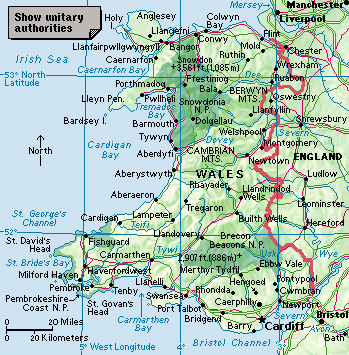Glamorgan is the leading industrial area in Wales. It stretches along the southern coast of Wales from Gower Peninsula in the west to just beyond Cardiff in the east. Cardiff is the capital and largest city of Wales.

Coal miners have tunneled deep under the narrow moorland valleys of northern Glamorgan. In the southwesten part of the area stand mighty steelworks. But along Glamorgan’s coastline are some popular seaside resorts and quiet sandy bays. Inland, the Vale of Glamorgan, in the south of the region, attracts many visitors each year with its beautiful rural scenery.
The name Glamorgan originated from a kingdom in South Wales during the early Middle Ages. Gwlad Morgan means the kingdom of Morgan, a king who ruled in the A.D. 900’s. Gradually, Gwlad Morgan came to be Glamorgan. The Welsh-language name for the area is Morganwg.
Glamorgan’s traditional dependence on heavy industry, especially steelmaking, has given way to a reliance upon light industries, such as electrical and electronic goods, and producing clothing. Port Talbot is still dominated by the manufacture of steel and chemicals. But the Swansea area has developed into a separate business center. The range of products manufactured in Glamorgan include automobile parts, chemicals, clothing, electrical and electronic goods; food products, health care products, high-voltage transformers, motor components, and steel; and videocassette recorders.
Farms in the region specialize in keeping beef and dairy cattle and raising sheep. Farmers also grow cereals and root crops. Most farmers keep hogs and poultry.
The earliest known inhabitant of Glamorgan was a man who lived about 25,000 years ago during the Paleolithic (Stone Age) Period. His skeleton was found in Paviland Cave (also called Goat’s Cave or Goat’s Hole) on the Gower Peninsula. Because of Glamorgan’s location, later prehistoric settlers from other lands passed through the area. Sometime between about 1000 and 100 B. C., the Celtic language spread through the region, possibly brought by traders or new immigrants. This language eventually developed into Welsh.
The Romans occupied the Glamorgan area and built forts at Cardiff, Neath, and Loughor. The Romans withdrew in the early A.D. 400’s. Soon after the withdrawal of the Romans, the Celtic missionary saints built monastic schools in the area.
The Vikings attacked the Glamorgan coast beginning in the 800’s. The Normans invaded Glamorgan in the 1090’s. They built towns around their castles at Cardiff, Loughor, Neath, and Swansea.
In 1536, the union of England and Wales was formalized by an act of Parliament. Glamorgan was a shire (county) from that date till 1974. It was greatly affected by the Methodist revival and the Industrial Revolution. In the 1800’s, the coal and iron industries flourished around Merthyr Tydfil and Cardiff, and Glamorgan’s population greatly expanded. During the 1900’s, these industries declined, but new light industries have replaced them.
